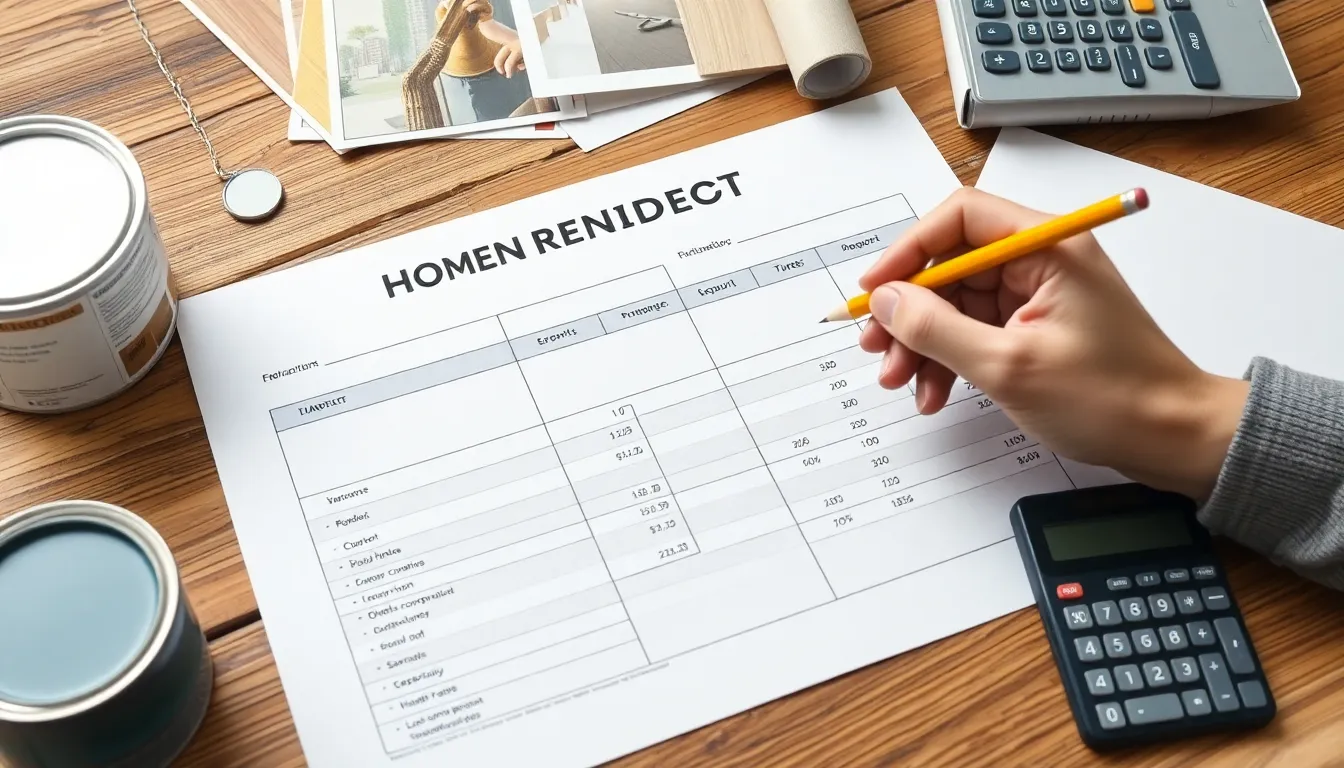Dreaming of that perfect kitchen or a cozy living room? Home renovations can turn those dreams into reality, but without a solid budget, they can also turn into a financial nightmare. Enter the home renovation budget template—a superhero in disguise, ready to rescue your wallet from the clutches of overspending.
Home Renovation Budget Template
Creating a realistic home renovation budget is essential for maintaining financial control during the renovation process. A well-planned budget helps homeowners allocate funds effectively and avoid unexpected expenses.
Importance of a Budget in Renovation
Establishing a budget in renovation ensures the project remains financially feasible. It allows homeowners to prioritize essential tasks while identifying areas for potential savings. Budgeting helps mitigate overspending on unnecessary upgrades or materials. With a clear financial plan, homeowners can track expenses as the project progresses, ensuring funds are responsive to changes. Overall, maintaining a budget fosters accountability and promotes thoughtful decision-making, ultimately leading to a smoother renovation experience.
Common Budgeting Mistakes to Avoid
Underestimating costs often leads to financial strain during renovations. Homeowners should factor in unexpected expenses that might arise, such as repairs or design changes. Relying on initial quotes without conducting thorough research frequently results in budget shortfalls. It’s crucial to leave a buffer for contingencies, ideally 10-20% of the total budget. Neglecting to account for permits or professional fees can create budget gaps. Lastly, skipping the tracking of expenses may cause overspending, leaving homeowners unprepared for the project’s financial demands.
Key Components of a Home Renovation Budget Template

Creating a comprehensive budget template requires attention to various components. Estimating costs accurately ensures that homeowners remain financially stable during renovations.
Estimating Costs for Materials
Calculating material costs requires a detailed breakdown. Begin by listing essential materials such as flooring, cabinetry, and fixtures. Research current prices at local suppliers or online marketplaces. For example, laminate flooring may cost $1 to $5 per square foot, depending on quality. Add a buffer of 10 to 20 percent to account for waste or price fluctuations. Include items like paint, drywall, and plumbing supplies in the list to avoid overlooking necessary purchases. This thorough approach helps create a realistic expectation for total material costs.
Labor Costs and Other Expenses
Labor costs constitute a significant portion of renovation budgets. Examine local contractor rates, which typically range from $50 to $150 per hour depending on expertise. Use estimates based on project complexity to gauge overall labor costs effectively. Identify additional expenses, such as permits and inspections, which can add hundreds or thousands to the budget. Consider hiring specialized tradespeople for tasks like electrical work or plumbing, as they often charge premium rates. A thorough understanding of these costs helps maintain budgetary control throughout the renovation process.

Creating Your Own Home Renovation Budget Template
Creating a personalized budget template can streamline the renovation process. Begin by listing all project components, ensuring each item has an estimated cost. Prioritize renovations based on necessity, separating must-haves from nice-to-haves. Allocate funds to each category, including materials, labor, and additional expenses like permits. Track spending continuously to maintain budget discipline.
Step-by-Step Guide
Start by assessing the entire renovation project. Identify areas that require work and research costs for materials and labor. Formulate a realistic timeline that accommodates potential delays associated with renovations. Consider incorporating a contingency fund, typically 10 to 20 percent of the total budget, to cover unforeseen expenses. Document each step and adjust estimates as new information arises.
Tools and Resources for Budgeting
Utilize online budgeting tools to enhance financial planning. Spreadsheets are effective for tracking costs and managing various components. Numerous apps cater specifically to home renovations, allowing for real-time budget adjustments. Government websites can provide local permit costs and regulations. Engaging with contractor estimates can further refine financial projections. These resources foster organized budgeting, promoting a successful renovation journey.
Tips for Sticking to Your Renovation Budget
Sticking to a renovation budget requires careful planning and active monitoring. Practical strategies help homeowners maintain financial control throughout the project.
Tracking Expenses Effectively
Monitoring expenses plays a vital role in budget adherence. Create a detailed list within the budget template that includes all costs. Regularly updating this list ensures transparency and accountability. Utilize spreadsheets or budgeting apps to record and categorize each expense promptly. Categorizing includes materials, labor, and permits, which helps track spending accurately. Cross-reference actual costs with estimated amounts to identify discrepancies. This ongoing review allows homeowners to see potential overspending early and adjust if necessary. Engage with contractors to clarify costs and avoid surprises as the project progresses. Keeping thorough records aids in maintaining budget discipline.
Adjusting Your Budget as Needed
Flexibility within a budget proves essential in a renovation project. Anticipate potential changes based on construction progress or unforeseen circumstances. Assess the budget regularly; adjust allocations to reflect changing priorities. If unexpected costs arise, such as structural repairs or material upgrades, revisit the financial plan to incorporate these changes. Adjustments might involve reallocating funds from less critical areas or increasing savings for specific tasks. Communicate with the renovation team to share budgetary constraints, ensuring all parties remain aligned. Open discussions foster problem-solving and help manage expectations effectively. Adapting the budget conservatively insightfully steers the renovation toward completion without overspending.

